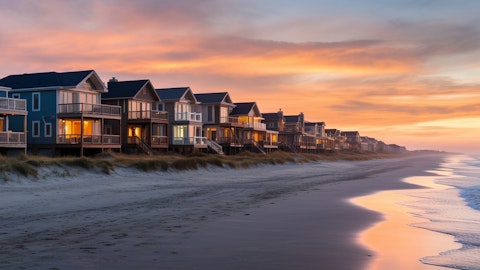On the market rates comparison tool that we alluded to is something that we had launched in a beta form. We’ve been listening to owners and updating it. And it really gives us more insight into, in fact how we are pricing stays in their home, what the forward curves looks like. It allows them to model some different criteria and changes that might impact their revenue. So this is for us a very day-to-day execution driven thing. We are seeing as we’ve shared improvements month over month over month in guest and guest scores in owner NPS. We think that there is a dynamic that others are having to deal with. But at the same time, we’re focused on what’s in our control and what we can do to drive that. On the dynamics that are in the industry overall, I’m sure that owners — our owners that are frustrated what they see bookings come off their home, what their home experience during the record highs in 2021 and 2022.
So, in some cases we think that there may be an aspect of people trying to find revenue that may not be there. It’s on us to be sure that we’re managing and then delivering those results and helping them understand the market as best we possibly can.
Jed Kelly: Thank you.
Operator: Our next question comes from the line of Sidney Ho with Deutsche Bank. Your line is open.
Unidentified Analyst: Hi, this is Ishaan [ph] on for Sidney. Thanks for taking our question. So on pricing, pricing has continued to trend down, but they still remain meaningfully above 2019 levels. So, do we have to walk back to 2019 levels before the pricing finds a button or it could stabilize in between somewhere from 2019 and where it is now? And what’s your expectation around that time line? And I have a follow-up.
Bruce Schuman: Yes, Ishaan, I can take the question. I would just say look, average gross booking value did decline year over year. We noted approximately 19% in the fourth quarter and gross booking value per night sold accounted for the majority of that decline. And we talked about as you’ll see when we file our 10 K, we saw our home count declined about 5%. And look, we think this is an industry issue, not just a cost to industry issue or a cost issue as Rob talked about. This decline is not catching us by surprise. We are working at it. We think our revenue management team is doing a nice job kind of adapting to this. I’m not going to get into a guide situation to talk about specifically exactly where it’s going to stabilize. We hope it stabilizes soon. So we are just focused on controlling what we can, controlling our cost structure, optimizing our rental income for homeowners as we can. That’s our focus.
Unidentified Analyst: Okay. Thank you for that. And then, just a follow-up. So occupancy has been trending down as we saw throughout 2023, but wish that should be inversely related to the pricing. So can you help us understand, why you think you’re not getting the benefit of pricing going down much actually the translating into better occupancy rate?
Bruce Schuman: Yes. Sure. I can I can try to take those also. Look nights sold declining. We showed you that metric. Night sold was down about 5% year over year. This is really a function of the number of homes on our platform and the rate at which we need to price those to sell those through. This implies our night sold per home that was relatively unchanged year over year in the fourth quarter that our home count was down about 5% leading to a 5% decrease in reported night sold. We can see the trend, we’ve been talking about for a while. That’s just played out again in the fourth quarter. It is declining year over year from kind of a record levels in ’21 and ’22. Remember we are constantly adjusting prices in real time trying to find that optimal mix between night sold, gross booking value per night sold. Again the goal is to maximize gross booking value for our homeowners and that’s what we’re focused on.
Unidentified Analyst: Well, thank you so much.
Operator: Next question comes from the line of Doug Anmuth with JPMorgan. Your line is open.
Unidentified Analyst : Hey. This is Pei-Yong [ph] for Doug. Thanks for taking the questions. I have two as well. When you’re looking out at the macro conditions and looking into the first half of this year, is it pretty expecting incremental headwinds or is this something more of a normalization of the trends that you saw and then you just need to cycle through it before seeing macro conditions normalize and start to grow again? So just curious, like if it’s incremental hedging that you’re expecting, or is it more of a normalization in cycling too?
Bruce Schuman: Yeah, look, it’s a great question. We, you know, as we said, we really don’t feel like it’s appropriate to kind of share a guide or a read on the forward view here, but I would just kind of go back through a couple of the drivers here. We’ve been talking about volatility, especially in the short end of the booking curve, and is that customers that are delaying decisions, deferring decisions, the dynamic of, kind of a normalizing of length of stay, customers picking alternatives, whether it’s hotels or as we’ve called out before, exploring other destinations. So we don’t know. It’s too early for us to call something on what those drivers are. But as we said, we’re watching it very closely.



